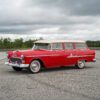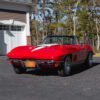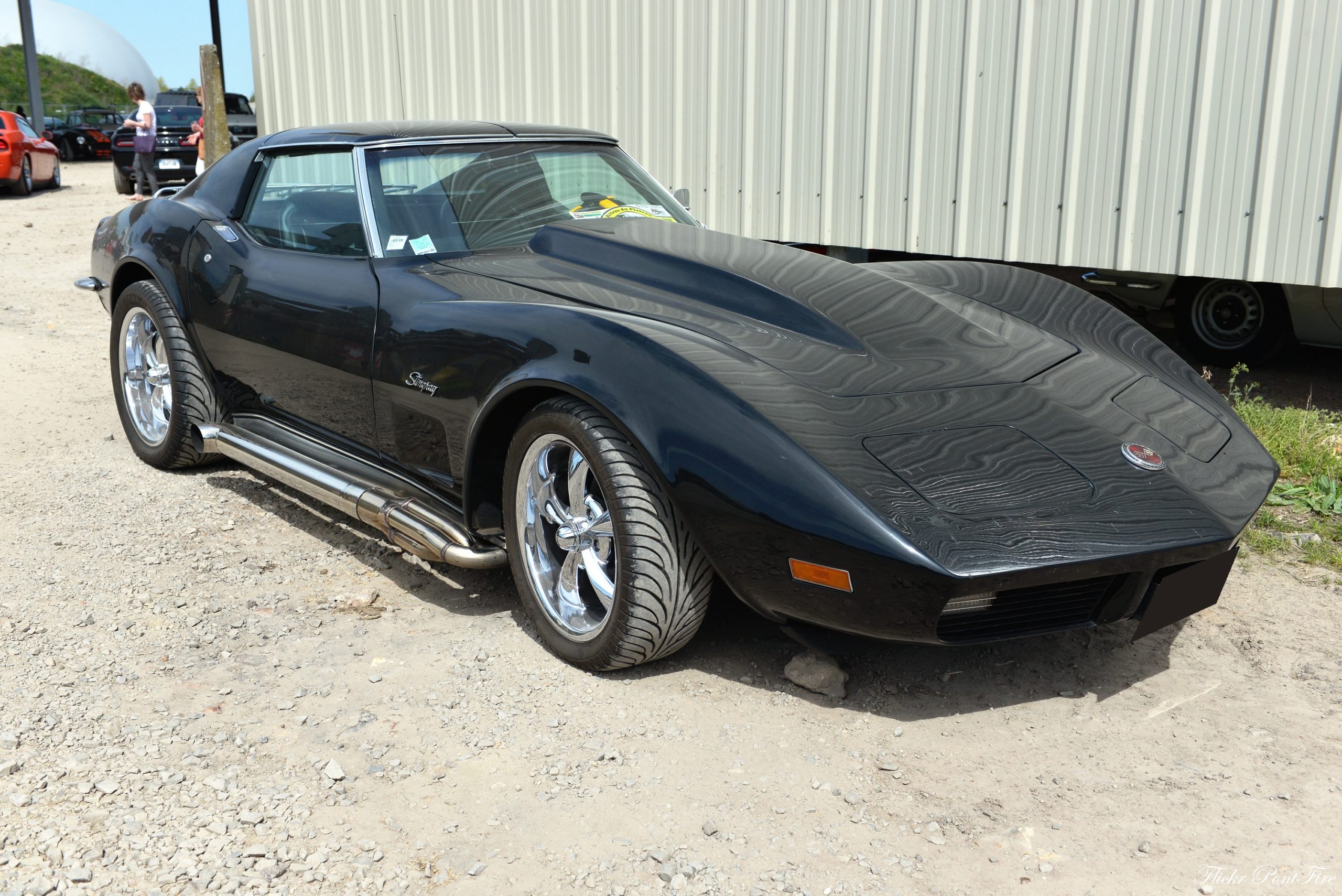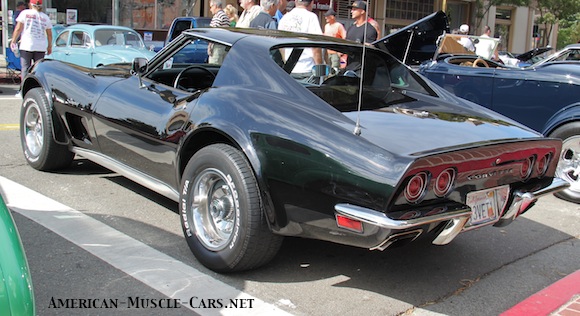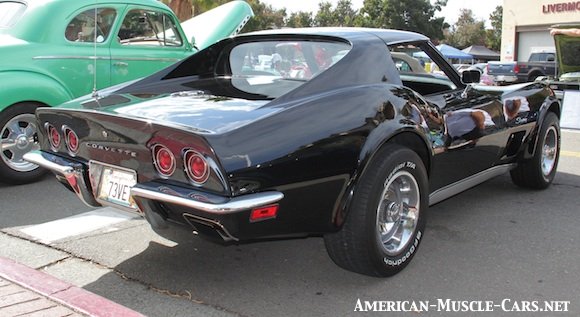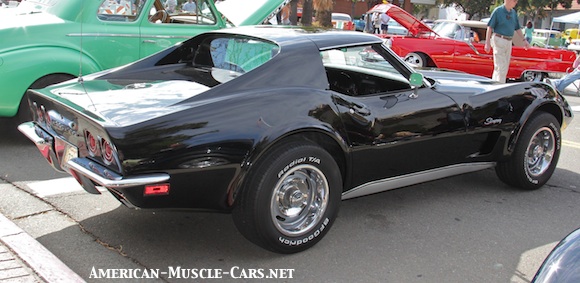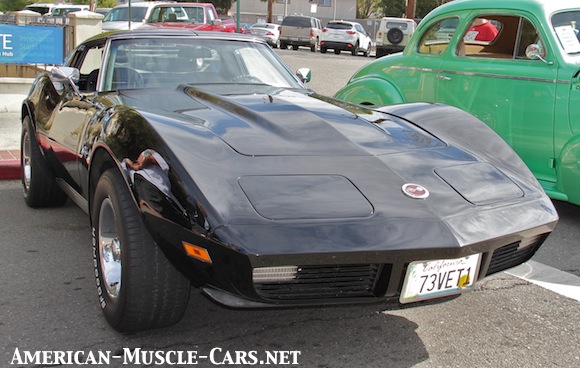1973 Chevrolet Corvette

1973 CHEVROLET CORVETTE – NEW LAWS FORCE CHANGE
Federal law was cracking down heavily on the American auto industry. It wasn’t just smog laws, no-lead gas, and fuel consumption mandates that were killing performance. It was also safety measures that were ramping up rapidly. Federal 5MPH frontal crash safety standards nearly killed the looks of the ’73 Camaro and Firebird, but the clever GM engineers squeaked by with extra bracing, but the Corvette design team wasn’t so fortunate. To meet the new standards (which said that the front end must be able to sustain a 5 MPH impact without damage), an entirely new front end had to be designed. Gone were the delicate chrome bumpers, and in their place was a large, long, pointed one-piece plastic nosecone that totally changed the looks of the car. They made the most of it, however, and did well enough with it, as this later-series C3 (3rd-generation Corvette) front end design remained, and was quite successful, through the 1982 model year.
1973 CHEVROLET CORVETTE – RUBBER BUMPER
Granted, it wasn’t a bad look, but it was just different from what Corvette fans were accustomed to seeing. While the front end got the new 5mph bumper treatment, the rear end stayed the same…for one more year, making 1973 the only year with a rubber front bumper and a chrome rear bumper. Corvette parlance refers to 1972-and-earlier cars as “Chrome Bumper”-cars, and 1973-and-later cars as “Rubber Bumper”-cars, even though technically the ’73 still has a chromed rear bumper. This was also the last year for the little “ducktail” spoiler in back.
1973 CHEVROLET CORVETTE – MORE CHANGES
Besides the new nose, there was a new hood with cold air induction, that also eliminated the trap door for the pop-up wipers. The rear lip of the hood now hid the entire affair. The new side vents behind the front wheels were now much simpler and without chrome trim, giving it a much more modern sleek look. This was the first year for radial tires. Inside, the rear window ceased to be removable. 4,000 VIN numbers in the 1973 Chevrolet Corvette VIN sequence were never produced (24,001 to 28,000), and black was never offered as a standard color, although it is believed that about 30 were painted black in the St. Louis plant.
1973 CHEVROLET CORVETTE PERFORMANCE, OR LACK THEREOF
In deference to safety regs, new side-impact beams were added to the doors. All this safety equipment added weight to the already weak-kneed Corvette, as compression ratios and horsepower continued to wain as GM struggled to meet emissions standards, and to run on the new no-lead, low-octane fuels. The L82 350 small block V8 was now producing a paltry 190 or 250hp, the first time Corvette horsepower had fallen below the 200-mark in many, many years. The top engine for the 1973 Chevrolet Corvette was the LS5 big block 454 rated at 275hp. Of course these were the new “SAE Net” ratings, so they were going to look lower anyway, but there was no doubt that performance was down, you could feel it in the seat of your pants. The 1970s were here, and it was not going to be a good time for American performance cars. The Corvette barely hung on, at times with performance that was almost laughable. But, everyone else’s cars were slow as well, so it didn’t matter as much. Somehow the Corvette soldiered through until the next generation arrived in ’84, bringing with it a whole new age of American muscle, this one by virtue of technology, not cubic inches.
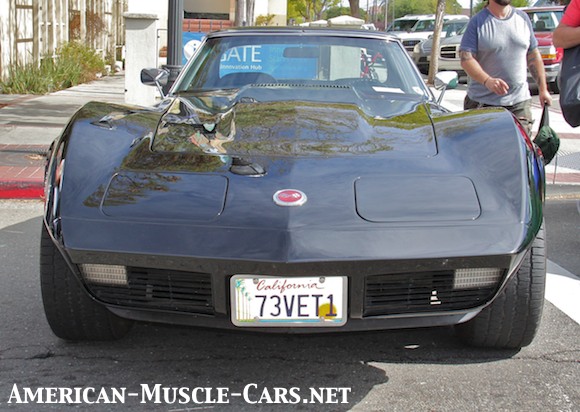
IS THIS YOUR CAR?
If so, and you would like the entire set of photos we took of it at the show, EMAIL US with the make, model, year & color of your car, along with the event. For $20 (via PayPal) we email you the complete folder of all the photos we took of your car that day. All are high-resolution, large-format JPG images that can be blown up or printed with photo quality. Capture that day with you and your car.
1973 Chevrolet Corvette SPECIFICATIONS
| Production (30,464)
Serial Numbers Base Price Wheelbase Overall Length Overall Width Overall Height Ground Clearance Track, F/R Wheel Size Tire Size ENGINE SPECS: Engine Type Displacement Bore & Stroke Block Material ENGINE OPTIONS: |
CONVERTIBLE
4,943 1Z67X3S400001-1Z67X3S434464 $5,398.50 98.0″ 182.5″ 69.0″ 4.5″ 58.7″ / 59.4″ 8″ X 15″ F70-15 OHV 90-degree V8, 5 main bearings 350 ci / 5.7 liters 4.00″ X 3.48″ Cast Iron |
COUPE
25,521 1Z37X3S400001-1Z37X3S434464 $5,561.50 98.0″ 182.5″ 69.0″ 47.9″ 4.5″ 58.7″ / 59.4″ 8″ X 15″ F70-15 OHV 90-degree V8, 5 main bearings 454 ci / 7.4 liters 4.251″ X 4.00″ Cast Iron |
| RPO
Displacement Horsepower Torque, lb/ft Compression Fuel System |
Base ZQ3
350 190 @ 4400 rpm 300 @ 2800 rpm 8.5:1 Rochester Q-jet |
LS4
454 275 @ 4000 rpm 390 @ 3200 rpm 8.5:1 Rochester Q-jet |
LT82
350 250 @ 5200 rpm 285 @ 4000 rpm 9.0:1 Rochester 4-bbl 2.5″ Dual Exhaust |


